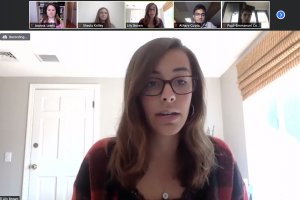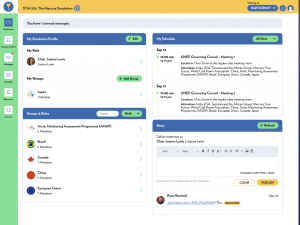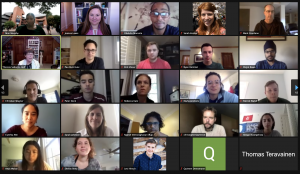STIA Transitions to a Virtual Semester
The STIA program has been adopting innovative teaching models and platforms to ensure students continue to be engaged and challenged in a virtual learning environment.
STIA faculty and staff have been working to ensure our students remain engaged as we continue to offer our courses virtually this year.
This is particularly apparent in the gateway course: Science & Technology in the Global Arena (STIA 305). This course, an introduction to the STIA major and minor, examines how science and technology affect international affairs, and how international affairs impacts scientific and technological developments.
This semester, STIA 305 is led by STIA director and professor Joanna Lewis, and team-taught with three other STIA core faculty members. Lewis led the redesign of the course several years ago into discrete modules to facilitate team teaching, and introduced the concept of using interactive simulations to accompany each module. Each module is taught by a different professor, with different modules featured each semester and new modules being added all the time.
For example this semester, Lewis led module 1, Science & the Global Environment, which featured a simulated negotiation of an international agreement on mercury pollution. The simulation was conducted both synchronously and asynchronously. During class, the teams (countries and key stakeholder groups) met in a UN-style plenary meeting. Outside of class the teams met internally and with each other to try to negotiate and resolve disagreements over key issues.

Lily Brown, the head of the China delegation, making a statement to the virtual plenary session during the Mercury Simulation
Other modules offered virtually during the fall 2020 semester include Global Health & Development led by Professor Emily Mendenhall, Energy Security & the Strategies of Nations led by Professor Theresa Sabonis-Helf, and Nuclear Technology & Security led by Professor Kathryn Olesko.
During the spring 2020 semester, STIA 305 had two modules in person and two modules taught remotely after the university shifted the mode of instruction after spring break. Professor Meg Leta Jones led the final module on Emerging Technologies, converting her popular “Frankentech Challenge” so that it would work in an online format. Students had to prepare a virtual “pitch” for a new information technology by choosing two already available technologies and combining them to produce a new and insidious for-profit application. Students could give their pitch live or pre-record a promotional video to air in class. The winning team (determined by class vote) pitched a technology called “Alt Pods” – earbuds that ensure you only hear good news.
The Alt-Pods Promotional Video, featuring students from STIA 305 spring 2020
The STIA 305 instructors are developing fun and interactive ways to engage the class during this challenging time using a variety of multimedia and web based tools.
For example, Professor Mendenhall’s global health simulation has the students responding to the outbreak of a fictional virus, the Giordano (named fondly after former STIA director Mark Giordano). The simulation begins with students watching a video interview between Professor Mendenhall and Professor Giordano where Giordano describes his discovery of the virus while on a (fictional) research expedition to the Democratic Republic of Congo.
Interview with Professor Mark Giordano about his discovery of the Giordano Virus
To get students excited about her module, the last of the semester, Professor Olesko developed a dramatic movie trailer to kick off the class’s module on nuclear security. The trailer uses imagery to introduce students to the key theme of her unit: how nuclear weapons transformed the national security state.
STIA 305 Nuclear Security Module Trailer
Since 10 of the students enrolled in the class are located overseas in remote time zones, the STIA 305 faculty are working to ensure these students primarily engaging asynchronously with the course material are able to stay involved and interact with their peers.
Professor Theresa Sabonis-Helf is leading a special virtual discussion section early Friday mornings for the international students. She is also making sure their location plays into her Eurasian Gas Crisis simulation. The difficulty associated with contacting them in remote time zones is a key part of the simulated engagement across different country delegations.
Running interactive simulations virtually is not without its challenges. To help overcome this, Lewis is working with a team of educational software developers at the University of Michigan to help pilot the use of Viewpoint – a tool developed specifically for classroom simulations. Lewis was introduced to the Michigan team by Georgetown’s CNDLS staff after discussions during a training session on remote teaching CNDLS held for the STIA department over the summer. Viewpoint is now being used in all four simulations for STIA 305 this semester to facilitate student communication.

The Viewpoint Simulation Tool
Finally, to bring the broader STIA community together, STIA moved its annual open house online. During this fall’s virtual open house, students heard from the STIA director, faculty, staff and the STIA curricular dean about new programmatic developments and course offerings as well as ongoing research efforts. Participants then were broken up into small breakout rooms to get to know each other and chat with faculty and staff.

The STIA Fall 2020 Virtual Open House
